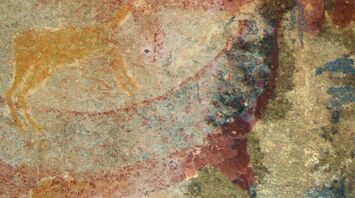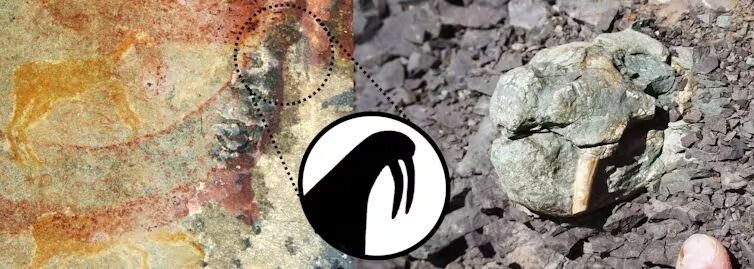South African Rock Art and Its Possible Inspiration from Fossils

A puzzling depiction of an animal on a cave wall in South Africa's Free State Province has left scientists scratching their heads. Bearing a resemblance to a walrus, a creature foreign to Africa, the painting confounds conventional identification. While some cryptozoologists have ventured that it might represent a sabre-toothed cat, one plausible interpretation is that it depicts a dicynodont, a prehistoric tusked reptile that existed long before dinosaurs.
Executed by the San, indigenous hunter-gatherers of South Africa’s Karoo region, this rock art showcases their detailed understanding of their environment. However, what is often overlooked is the ancient past encapsulated in their surroundings. The San resided alongside fossil footprints, bones, skulls, and teeth of extinct reptiles. Recent findings indicate that the San discovered dinosaur bones in Lesotho near the Free State and even etched dinosaur footprints onto cave walls.
In new research, it's posited that the mysterious creature in the Free State cave art is a dicynodont. First described scientifically in 1845 by Sir Richard Owen, dicynodonts represent a key link in mammalian ancestry, descending from therapsids. The fact that the painting predates 1835—the year the San departed from the region—indicates the San may have known about dicynodonts a decade before Western science officially identified them. This suggests the existence of a sophisticated, albeit forgotten, indigenous palaeontology within the Karoo.

The Karoo region, particularly parts of the Free State, is rich with dicynodont fossils, evidenced by the large number of skulls and teeth scattered across exposed rock. These mammalian ancestors, dominant around 265 to 200 million years ago with varying sizes and forms, left a substantial fossil record. A San myth tells of "enormous brutes," which likely refers to these fossil discoveries.

A specific engraving—the 'Horned Serpent' at a farm named La Belle France—depicts an animal with downward-pointing tusks unlike any existing African fauna, but reminiscent of a walrus. Dismissing possibilities like pigs or elephants, the research supports that this animal is a dicynodont, suggesting that the San reconstructed this extinct being through their artistic imagination, based on fossils found nearby. Crucially, the animal's banana-like curve ("death pose") and spot-covered body match characteristics seen in well-preserved dicynodont specimens.
These findings take on additional significance in their cultural context. Researchers note that "rain-animals," a term in San mythology, frequently metamorphose in form and are inspired by aquatic life. This dicynodont painting could represent the first known instance where a fossil species served as the basis for such mythical creatures, potentially irradiating rain rituals and linking the extinct animals to the shamanistic realm of the dead.
Ultimately, this research into San rock art suggests that fossils once embedded with magical properties may have been woven into their spirituality and belief systems, prompting a fresh understanding of their cultural expressions.
Earlier, SSP wrote that SpaceX's Starlink satellites pose a threat to radio astronomy.



















